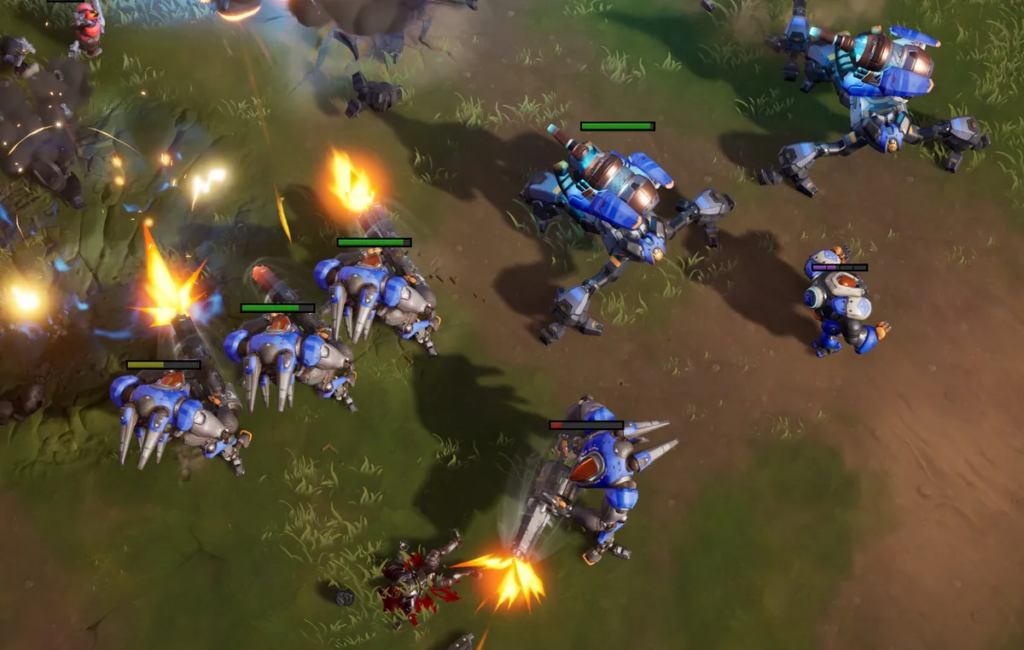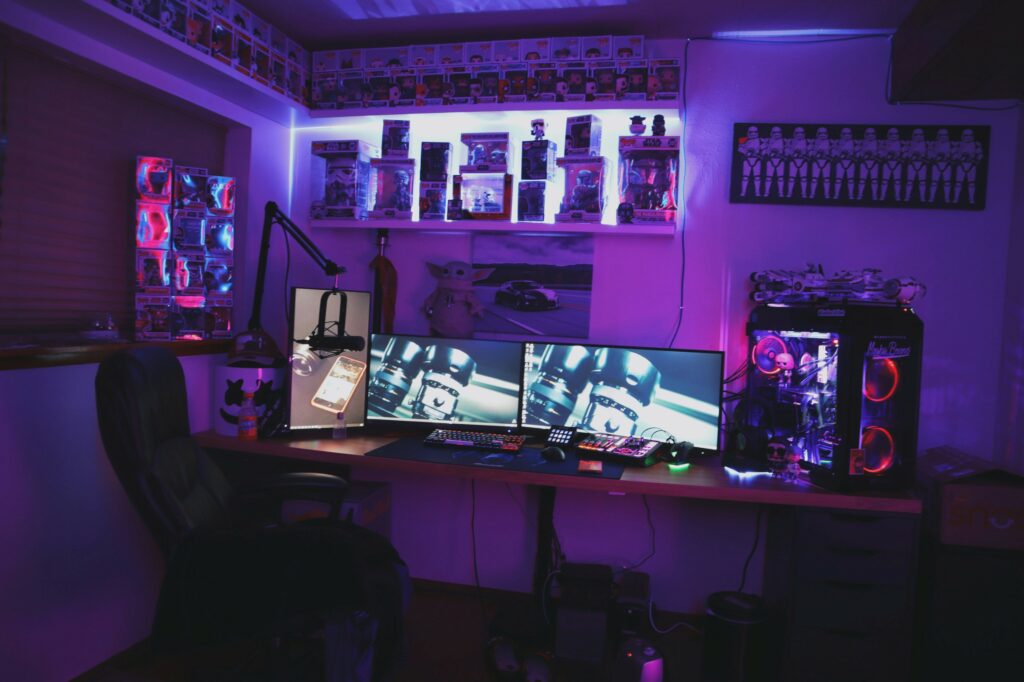
Frost Giant Studios, a startup founded by ex-Blizzard employees in 2020, is on a mission to revive the golden age of real-time strategy gaming. It recently ran a closed beta for its upcoming free-to-play title, Stormgate, and secured additional funding through a successful Kickstarter campaign. The studio is also venture capital funded and has raised $35M to date.
Real-time strategy games had their heyday in the '90s. The phenomenon started with Dune II in 1992, but the genre really blew up with Warcraft (1994) and Command & Conquer (1995), which expanded upon Dune's design template.
By the late nineties, everyone and their dog were building an RTS. Eventually four franchises rose above the competition: Warcraft, StarCraft, Age of Empires, and Command & Conquer. StarCraft played a key role in the birth of esports: in the 2000s, StarCraft was the de facto esports RTS, only ousted by its 2010 sequel StarCraft II.

By the 2010s, the strategy genre was dominated by MOBAs such as League of Legends and Dota 2, both born out of RTS mods. The first MOBA, Aeon of Strife, was a custom map for StarCraft: Brood War. Defense of the Ancients, a map for Warcraft 3: The Frozen Throne, was a later evolution of the idea. Eventually, of course, Riot created League of Legends, which re-imagined the MOBA as a standalone game.
Today, StarCraft II remains the last true blockbuster RTS. One of the modern experts in the genre, Relic Entertainment, has done well with its Company of Heroes series, but the third instalment was released this year to mixed reviews. Relic was also the developer of Microsoft-published Age of Empires IV, which was received well, but Relic's post-launch support for the title has been meager. Combined with news of recent layoffs at the studio, it doesn't look like Relic will release a StarCraft killer soon.
However, Relic and Frost Giant are not the only companies trying to crack the RTS puzzle: US-based Petroglyph Games released The Great War: Western Front earlier this year, albeit to a lukewarm response. Danish studio Slipgate Ironworks is working on its Command & Conquer-inspired title Tempest Rising, and Canadian studio Blackbird Interactive plans to ship Homeworld 3 in 2024.
Making a great RTS game is hard. StarCraft II’s celebrated gameplay results from hundreds of small decisions gone right, all built on the team’s experience of shipping multiple RTS games. Ideal pathfinding, snappy unit responsiveness, an engaging single-player campaign, and tight competitive faction balance are non-trivial issues, to name a few. RTS developers must execute all aspects of the game at the highest level to deliver an experience that can leave a mark; if Frost Giant has genuinely been able to attract the best RTS talent from Blizzard, it has the best chance of success at claiming the RTS throne.
The response to Stormgate’s closed beta seems to be generally positive, if somewhat reserved. In an attempt to entice fans of both franchises, the gameplay is essentially a mix of Warcraft III and StarCraft II. The maximum resource supply is higher than in either of Blizzard’s landmark titles, allowing for larger armies and more units; however, the time to kill is longer than in StarCraft II, resulting in a slower pace of combat more akin to Warcraft and Age of Empires.
The battles are certainly epic, but suffer from lack of visual clarity. Indeed, the choice of art style as well as readability issues are among the primary problems that beta players report. Still, considering all that can go wrong with a high-profile beta test, Frost Giant is likely very happy with the response.
What does success look like for Frost Giant? First, Stormgate must unite RTS players. Although StarCraft II is the most active in professional esports, the competitive community is split somewhat evenly between Age of Empires II, Age of Empires IV, Warcraft III, and StarCraft II. Even this outcome might not be enough for Storm Giant's venture backers. Famously, one of the StarCraft II expansions, Wings of Liberty, is claimed to have made less money than a $15 sparkly pony in World of Warcraft. To really hit big, Stormgate must revitalize the genre completely, and Frost Giant must acknowledge that its main competitors are not StarCraft and Age of Empires, they are League of Legends and Dota 2.
As daunting as that may be, one should not underestimate the potential of so-called niche games executed exceptionally well. Just ask Larian – before Baldur's Gate 3, turn-based RPG games were considered in the same category.
A Word from Our Sponsor: OVERWOLF

Integrate Safe UGC Into Your Game with CurseForge For Studios
Overwolf is an all-in-one platform that lets creators build, share, and monetize in-game apps, mods, and private servers. With over 165,000 creators, and 41M monthly active users, Overwolf supports the world’s most popular AAA titles such as League of Legends, Minecraft, World of Warcraft, and 1,500 other games.
For game developers, Overwolf offers CurseForge For Studios. CurseForge For Studios is a white-label solution that lets game makers and publishers easily integrate mods safely and seamlessly into their games, both existing and new, at zero cost. It’s battle-tested by AAA studios and games, including Maxis (The Sims™ 4), Studio Wildcard (ARK), TakeTwo Interactive (KSP), and others.
CurseForge For Studios offers:
- Cross-Platform Modding: Integrate Overwolf’s open-source SDKs and plugins to let players discover and install mods in-game, across all platforms and storefronts.
- Full Analytics Dashboard: Get a full modding usage dashboard to learn which mods are popular.
- Safe and Secure Moderation: Studios define policies and guidelines on what is permitted, and these are then enforced by Overwolf – with only authorized content being published.
- Creator Relations and Payments: CurseForge supports creators with monthly payments, equity investments, developer contests, and hackathons to get their creative juices flowing, and kickstart content creation for your game.
Content Worth Consuming

It’s All a Game (Colleen Sullivan): “This is an essay about the intersection of Web3 and games written by Colleen Sullivan, Co-Head of Venture at Brevan Howard Digital. It’s intended for anyone who enjoys games and is curious how Web3 technologies may impact the gaming industry. This essay is written in a modular fashion enabling readers to skip around and read the sections that are of most interest.”
Inside Bombay Play: Bringing Hyper Social Games From India To The World (Rise and Play Podcast): “In this episode, we are joined by Oliver Jones, CEO and co-founder of Bombay Play, one of the leading gaming studios in Bengaluru, India. Oliver shares his journey in the gaming industry before founding Bombay Play, from working at Zynga and Glu to founding his first company Moonfrog Labs (acquired for USD 90 million by Stillfront in 2021).”
How Generative AI Will Reshape Gaming (Slush): “AI is elevating every industry — and gaming is no exception. In platform shifts like these, generational companies won’t only improve upon existing workflows with faster, better, or cheaper developer tools; they will create completely novel, previously impossible user experiences—like intelligent NPCs and simulations, immersive procedurally created worlds, and even AI co-pilots for player-led game design. The potential is infinite, but who will grab it first: incumbent publishers or startups that challenge the status quo?”
EG-7: A Multi-Bagger in the Making (Atai Capital Management): “Enad Global is a PC/Console video game developer listed on the Nasdaq First North Exchange. After a tumultuous past filled with dilutive acquisitions, setting and missing high expectations, and a less-than stellar management team, the company is finally positioned for the future with a significant net cash balance (~28% of its market cap today) and a new S-Tier management team and board.”
Right subgenre, 'wrong' result: analyzing disappointing game ROI (GameDiscoverCo): “Well, it’s the middle of the week, and it’s a particularly messy time for layoffs and studio closures in the PC/console game biz - search Google News if you don’t believe us. We cover platforms, but the platform supply/demand squeeze - alongside overinvestment from earlier times, in hindsight, is affecting studios. We’re not sure there will be light at the end of a tunnel for a while. But we really feel for those affected. And all we can do is talk about and document the trends (which games are launching into the market strong, and why?) and hope it helps.”








